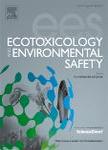版权所有:内蒙古大学图书馆 技术提供:维普资讯• 智图
内蒙古自治区呼和浩特市赛罕区大学西街235号 邮编: 010021

作者机构:East China Univ Sci & Technol State Environm Protect Key Lab Environm Risk Asse Sch Resource & Environm Engn Shanghai 20023Z Peoples R China Yonker Environm Protect Co Ltd Branch Shanghai Shanghai 200051 Peoples R China Longking Environm Protect Co Ltd Branch Shanghai Shanghai 200331 Peoples R China
出 版 物:《ECOTOXICOLOGY AND ENVIRONMENTAL SAFETY》 (生态毒物学与环境安全)
年 卷 期:2019年第169卷第Mar.期
页 面:273-281页
核心收录:
学科分类:0830[工学-环境科学与工程(可授工学、理学、农学学位)] 1001[医学-基础医学(可授医学、理学学位)] 08[工学]
基 金:Shanghai Municipal Science and Technology Commission Program [17DZ1202304]
主 题:Caenorhabditis elegans Tetrabromobisphenol A A step chronic exposure Repeated chronic exposure Oxidative stress Environmental risk
摘 要:To better understand the toxicity of tetrabromobisphenol A (TBBPA), its effects on the model nematode Caenorhabditis elegans were investigated. Following a step and repeated chronic exposure from L4-larvae to day-10 adult, physiology endpoints (growth and locomotion behaviors including head thrashes, body bends and pumping rate), biochemical endpoints (reactive oxygen species, superoxide dismutase activity, catalase activity), and molecular stress-related gene expression were tested at environmentally relevant concentrations of TBBPA (0.01-100 mu g/L). The results showed that concentrations of TBBPA greater than 10 mu g/L, clearly influenced the physiology behaviors (growth and locomotion endpoints). Under repeated exposure, C. elegans exhibited adaptive responses in head thrashes and pumping rate. Compared to toxicity evaluation following repeated chronic exposure, a significantly greater response was induced at the same concentration following a step chronic exposure. Reactive oxygen species production was significantly enhanced following a step and repeated TBBPA exposure at the concentrations of 1 and 10 mu g/L, respectively. qRT-PCR showed that ctl-1, ctl-2, ctl-3 and sod-3 expression significantly increased, which was obviously correlated with physiological and biochemical behaviors under both treatment conditions according to Pearson correlation test analysis. sod-3 and ctl-2 mutations were more sensitive than the wild-type N2 under a step chronic TBBPA exposure at a level of 10 mu g/L. Thus, chronic exposure to TBBPA induces an oxidative stress response in C. elegans, with ctl-2 and sod-3 playing a vital role in TBBPA-induced toxicity in nematodes.